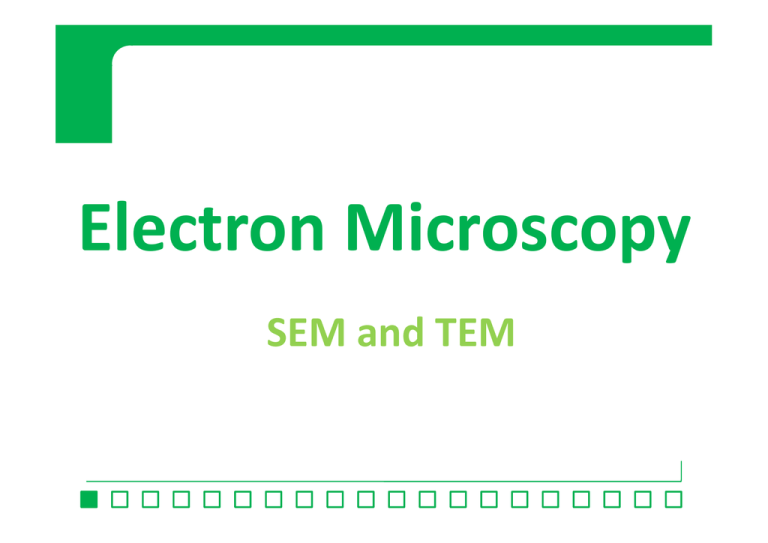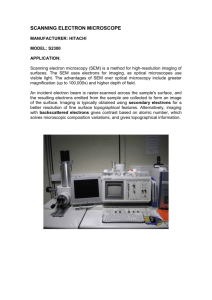SEM and TEM SEM and TEM
advertisement

El t Electron Microscopy Mi SEM and TEM SEM and TEM Content 1. Introduction: Motivation for electron microscopy 2 Interaction with matter 2. Interaction with matter 3. SEM: Scanning Electron Microscopy 3.1 Functional Principle 3.2 Examples 3.3 EDX (Energy‐Dispersive X‐ray spectroscopy) 4 TEM: Transmission Electron Microscopy 4. TEM: Transmission Electron Microscopy 4.1 Functional Principle 4.2 Examples 4.3 Comparing SEM and TEM d 4.4 HAADF (High Angle Annular Dark‐Field Imaging) 1 Motivation for EM 1. Motivation for EM Resolution of light microscope is limited: λ sin Θ = 1.22 ⋅ D • wavelenght of visible light wavelenght of visible light • less diffraction for smaller wavelenghts ¾ possible magnification: ~ 2 000 [ ] [1] 1 Motivation for EM 1. Motivation for EM Different approach: use electrons instead of light • Access Access to much smaller wavelengths to much smaller wavelengths h λ= (3.7 pm for 100 keV) p • electrostatic/electromagnetic lenses l t t ti / l t ti l instead of glass lenses ¾ possible magnification: ~ 2 000 000 [2] 2 Interaction with matter 2. Interaction with matter Backscattered electrons Secondary electrons y Auger electrons Transmitted electrons Transmitted electrons X‐Rays specimen phonons 2 Interaction with matter 2. Interaction with matter Topography and composition Topography p g p y Structure and composition Structure and composition Composition Backscattered electrons Secondary electrons y Transmitted electrons Transmitted electrons X‐Rays 2 Interaction with matter 2. Interaction with matter 2 different approaches: Backscattered and B k d d secondary electrons SEM T Transmitted electrons i d l TEM 3 SEM 3. SEM Scanningg Electron Microscopy 3 1 Functional Principle 3.1 Functional Principle Electron source Condenser lens Scan coil Objective lens Specimen + Detectors 2‐25 kV e‐ 3 1 Functional Principle 3.1 Functional Principle e‐ Electron gun Condenser lens Scan coil Objective lens Specimen + Detectors coils N N S coils 3 1 Functional Principle 3.1 Functional Principle Electron gun e‐ Condenser lens Scan coil Objective lens Specimen + Detectors Waveform generator Detector signal 3 1 Functional Principle 3.1 Functional Principle Electron gun e‐ Condenser lens Scan coil Objective lens Specimen + Detectors coils coils f 3 1 Functional Principle 3.1 Functional Principle Electron gun Condenser lens Scan coil Objective lens Specimen + Detectors e‐ El t Electron‐ and d Lightdetectors 3 2 Examples 3.2 Examples Photonic crystal in silicon substrate WSI, D. Dorfner Nanowires in silicon substrate WSI, D. Pedone 3 3 Energy Dispersive Systems (EDX) 3.3 Energy Dispersive Systems (EDX) e‐ e‐ Bremsstrahlung → X‐ray Continuum Electron filling holes → Characteristic X‐rays Information about chemical composition p 3 3 Energy Dispersive Systems (EDX) 3.3 Energy Dispersive Systems (EDX) Solid state X‐ray Solid state X ray Detector Detector N2 Si(Li) coldfinger X‐ray ‐X‐ray creates hole/electron pairs (3.8 eV necessary per pair) ‐Number Number of pairs and current are a measure for X of pairs and current are a measure for X‐ray ray energy energy 3 3 Energy Dispersive Systems (EDX) 3.3 Energy Dispersive Systems (EDX) Alloy of aluminum and tungsten [3] reminder 2 different approaches: Backscattered and B k d d secondary electrons SEM T Transmitted electrons i d l TEM 4 TEM 4. TEM Transmission Electron Microscopy 4 1 Functional principles 4.1 Functional principles Electron gun Condenser lenses Object Objective lens + intermediate lens + projective lense l 50‐ 400 kV e‐ 4 1 Functional principles 4.1 Functional principles Electron gun Condenser lenses Object Objective lens + intermediate lens + projective lense l e‐ 4 1 Functional principles 4.1 Functional principles e‐ Electron gun Condenser lenses ~100nm specimen p Object Objective lens + intermediate lens + projective lense l scattered direct beam 4 1 Functional principles 4.1 Functional principles Electron gun Condenser lenses Object Objective lens + intermediate lens + projective lense l 4 2 Example 4.2 Example Crossectional analysis of a conductor nanogap device WSI, S. Strobel WSI, D. Pedone 4 3 Comparison of SEM and TEM 4.3 Comparison of SEM and TEM SEM: scans with a focused point TEM: illumantes whole sample 4.4 High Angle Annular Dark‐Field 4 4 High Angle Annular Dark Field Imaging (HAADF) g g( ) ‐ used in STEM (scanning transmission electron microscopy) ‐ rayleigh scattering at high angles rayleigh scattering at high angles ‐Angle depends on the atomic number Z: ‐electron intesity: I ∝ Z 2 ¾ by messuring the electron intensity, while scanning over the sample, information about the chemical compositio can be aquired can be aquired Thanks for your attention. reference ‐ TUM chemie department: http://www.ch.tum.de/em/emlabor/methoden/rem.htm http://www ch tum de/em/emlabor/methoden/tem htm http://www.ch.tum.de/em/emlabor/methoden/tem.htm ‐wikipedia: http://en.wikipedia.org/wiki/Electron_microscopy http://en wikipedia org/wiki/Transmission electron microscope http://en.wikipedia.org/wiki/Transmission_electron_microscope http://en.wikipedia.org/wiki/Scanning_Electron_Microscope http://en.wikipedia.org/wiki/Energy‐dispersive_X‐ray_spectroscopy http://en wikipedia org/wiki/HAADF http://en.wikipedia.org/wiki/HAADF http://en.wikipedia.org/wiki/EELS ‐ Transmission Electron Microscopy, D. B. Williams and C. B. Carter ‐ Scanning electron microscopy and X‐ray Microanalysis, G. Lowes g py y y , ‐ electron microscopy in solid state physics, H. Bethge and J. Heydenreich reference [1] http://en.wikipedia.org/wiki/Optical_microscope [2] http://de.wikipedia.org/wiki/Elektronenmikroskop [3] http://www ch tum de/em/emlabor/methoden/rem edx htm [3] http://www.ch.tum.de/em/emlabor/methoden/rem‐edx.htm


